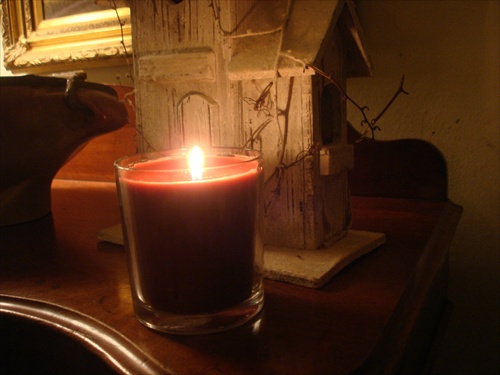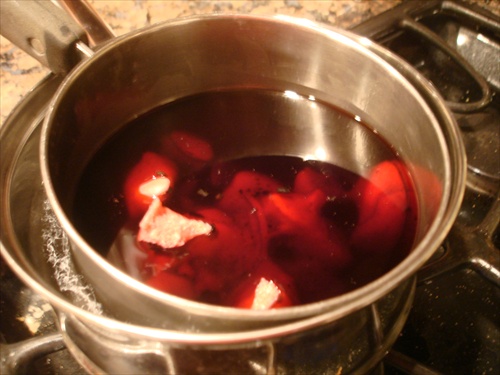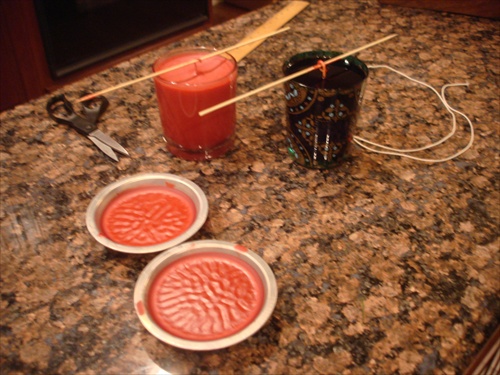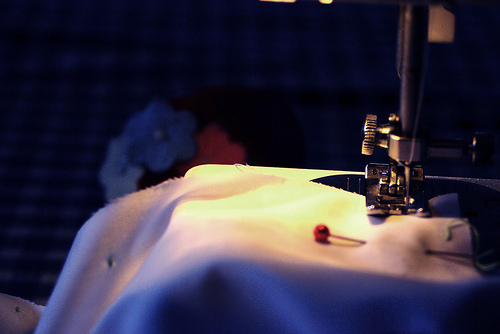Posts Tagged ‘Frugality’
Shards of Golden Light
I wrote this post over a year ago, but it still holds true today; we gather and store burned down remnants of candles all year long, and we turn them into new candles in the fall. The box we store the bits and pieces in may be larger than when we first started, and the collection of fire safe containers has definitely grown, but the process of making light for winter remains the same–melt, pour, set, light.
I love the glow of candle light. It casts a warm comfortable feeling over the entire room. From the first hint of fall’s chill until buds burst in the warm spring air there are candles burning in my little farmhouse.
They are on my mantel, set in a collection of thrift store candle holders on my hearth, on the window sill of my kitchen, in my bedroom and even along side my bath tub. It’s amazing how much that little flickering flame of light can calm and restore and bring peace at the end of a busy day.
But, what once was a necessity for lighting a room, reading a newspaper, or illuminating a path has become almost a luxury. Years ago I could buy candles for a few dollars, but now they cost more than I spend on a bag of chicken feed. Being the frugal farmer that I am however, I have found a few tricks to keep my love affair with candles without breaking the bank.
One is to use the department store gift cards I receive in the mail. You know the ones I’m talking about…where they give you $10 off of a purchase to entice you into the store, hoping you’ll spend more. I’m too savvy for their ploys, though. I am usually able to find 3” pillars, or jarred candles or 6 votives for just under the minimum $10 (which I am still able to use my card to purchase). More times than not I walk out of the store with beautiful scented candles for no money at all. How’s that for farm girl frugality?
My second method to keeping the candle flames flickering is to save all the little bits and pieces of burned down candle wax. I keep them in a ziplock bag. When I have gathered enough pieces of the same color (or similar color) I melt them down to make new candles. I save all the old jars from any jarred candles because they are made of tempered glass and safe for pouring hot wax into.
For just a few dollars in a package of wick and a $2.00 pot I bought at the thrift store I can make a new candle in less than 30-minutes and enjoy the glow of my recycled wax for hours. How great is that!
To make your own candles out of bits and pieces all you need is a stainless steel pot (one you don’t mind getting covered with wax), a larger pot, an old jarred candle jar and a package of wicks.
Now—fill the larger pot half way with water and set it on a medium flame. Cut the wick 1-inch taller than the jar, tie a knot at one end, wrap it around a pencil or chop stick a few times so it sets nicely on the bottom of the jar.
Place the wax bits in the smaller pot and set it inside the larger pot–like a double boiler. Let the wax melt, stirring occasionally at first, then constantly as the wax gets hotter. When all the wax has melted, gently pour it into the prepared jar. (if your wax has bits of wick or debris in it, pour it through a small hand-held sieve). Let it set overnight. When you’re ready to burn the new candle, cut the wick to 1/2-inch and light it.
Voila! That’s all it takes to keep the candle glow burning all the way through to spring.
The Power of a Dollar
Every so often I go on a rampage of frugality. It’s more like a feeling of sickness, a sickness of spending money, sick of the cost of things, sick of pulling out my wallet everywhere I turn, sick of how a dollar doesn’t go as far as it use to. Just plain sick. This past week has been one of those times as the cost gas, water and food increasing almost on a daily basis fills my subconscious.
On the way home from work I swung by the library to peruse their daily used book sale to see if I could find any interesting title additions to my growing library. As I walked the stacks those money infused thoughts crept to the forefront. It drew me to think how and when and where money flitters away. It’s not a great amount, mind you. I’m already a fairly frugal, penny pinching saver, always trying to find new ways to spend less on what the farm and I need. As I drew my hand over the books looking for titles that would interest me it came to me…for a buck I could buy a book, a book that would educate me or entertain me. I stood there staring, thinking really, about how many things I have or could buy with a buck. It was amazing to me that in a short period of time I could list more that a dozen things I have bought that were only a buck.
There was the trip to my favorite ethnic market where the produce is plentiful and the prices reasonable and I could buy…
2 pounds of carrots
5 grapefruit
A string of garlic
3 heads of lettuce
4 pounds of onions
1 cantaloupe
¼ pound of Feta cheese
Or, 1-1/2 pounds of chicken quarters, for a buck.
Then there was the thrift store sale where I bought a new pair of shorts and a few more clay pots for vegetable or flower starts, for a buck.
During a trip to town running errands for work I bought an iced tea to stave off the heat…for a buck.
At a garage sale I bought a galvanized water trough, for a buck.
On Craigslist, I bought iris bulbs, for my ever expanding flower garden, two bags for a buck.
I can also buy two stamps, a fat-quarter of sale quilt fabric, salt licks for rabbits, a scoop of grit for chickens, and a few dog treats, for a buck.
At the library that day I bought a 4-part mini-series, for a buck.
And, of course…a book.
It was proof positive that the dollar has more buying power than I sometimes think. It was nice to sit and reflect on how many things can (or have) been purchased for a dollar. The more I reflected, the more my frugal rampage dissipated, until finally it disappeared all together. Funny how some worries retreat as fast as they come on.
What can you buy for a buck? It’s out there ya know. We only have to look.
It’s Sew Easy
There are so many skills to learn as a homesteader – building, gardening, tending livestock are the one’s we think of first. But, there are plenty of indoor skills to be learned as well – canning, cooking, baking and of course sewing and knitting. Sewing and knitting are two of the most practical skills a homesteader can learn. They give you the ability to mend damaged clothes, extending the life of your clothes; they enable you to make old garments into new useful pieces; and they allow you to pursue something fun that in the end produces something practical and made for you.
Now, I’m not a highly skilled seamstress, nor a tailor. You won’t see me or any of my sewing projects for that matter on the latest episode of Project Runway. I’m a practical sewer. I sew to mend my daughter’s jeans or make them into shorts that will carry her through the next summer season. I make quilts out of scrap fabric and garments that are no longer useful or are too worn out to save. I fix hems, replace buttons, shorten waistbands…you get the idea.
The lack of skill in this area and other home keeping related skills is a sad commentary, I think, on our school system and society in general, but I will refrain from political commentary. I remember taking Home Ec in High School. We learned cooking, sewing, household budgeting, money management and frugality. But most women I know can’t even replace a button. And something simple like fixing a hem requires a trip to the dry cleaners or tailors shop.
While in 4-H I learned more about sewing from my project leader. I remember sitting around her dinning room table with the other girls (and some boys) as she taught us how to make simple garments like skirts, shorts, tote bags, aprons and pj pants. As our skills improved our projects got more intricate – jumpers, coats, dresses, suits.
I haven’t sewn full garments in years, but my turn to a simpler life has reawakened my desire to be more handy in this area. And, why not; making your own clothes is a guarantee that what you wear is of high quality and custom made to your tastes, not just a comeback fad of old-fashioned practicality.
Before you go out and buy a pile of fabric with patterns to match, I strongly suggest putting together your own basic sewing basket or kit. Nothing fancy is needed. A basket or lidded tin will do the trick, but these are must-haves for any would-be sewer so that all your supplies will be in one place when you get ready to start that project. It just makes life simple. My sewing basket is an old wooden, lidded box that has feet and a stationary handle. I found at a thrift store, and inside it contains
– Scissors
– Cloth tape measure
– Straight pins and a pin cushion
– Thread in assorted colors
– Seam ripper
– Needles, different sizes
– Washable fabric pen and pencil
If you think you’ll be using a sewing machine most of the time, you’ll also want to have sewing machine needles and bobbins for your machines make and model, but the above list is the bare-bones basics for simple hand sewing.
Knitting doesn’t take as many supplies as sewing does, which means less cost in the beginning. But, the results are very similar – handmade garments that reflect your personal tastes and are useful. If you’re just beginning, try using large diameter knitting needles and a thick, chunky yarn. I suggest this for a couple of reasons, 1) it’s easier to see what you’re doing when everything is larger, and 2) you’ll finish your project quickly which will give you a sense of accomplishment and satisfaction. My friend Nancy can finish a hat in the time it takes the Women’s Club to finish their meeting. Now that’s speed knitting!
Once you get the hang of knitting, you’ll see all the possibilities because each project – from scarf to hat to sweater – starts with just one simple row. After that it’s all good.
So – thread that needle or cast on that yarn folks! You know what they say about idle hands…
To try your hand at either sewing or knitting, check out these easy projects and inspiring websites. Or, for a more communal experience check out your local fabric shop or knitting store.
Free Tote Bag Patterns:
http://tipnut.com/35-reusable-grocery-bags-totes-free-patterns/
http://www.simplicity.com/
http://www.knittinghelp.com/
http://www.knitpicks.com/knitting.cfm





Recent comments
Aenean nonummy hendrerit mauris. Phasellus porta.